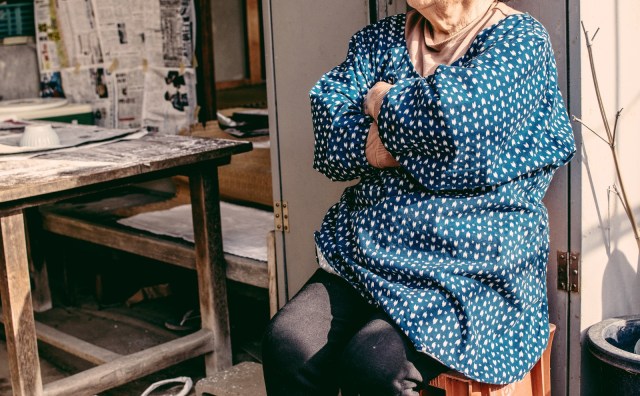
Not no country for old women.
Last Monday was “Respect for the Aged Day” in Japan, which is a holiday to celebrate those who have reached the upper years of life by treating them to dinner or with gifts. This is good news for the struggling economy as the number of folks in their golden years who are owed presents is reaching new heights.
To start, the overall population of Japanese people over the age of 65 has swelled by 300,000 this year to a record high of 36.17 million. To put that in context, that’s about a million shy of the entire population of Canada and accounts for about 28.7 percent of the Japanese population.
Breaking that down by sex, 31.6 percent of all Japanese women are seniors as are 25.7 percent of Japanese men.
However, the rise in people over the age of 70 was even sharper with 780,000 new septuagenarians since last year. With that, Japanese women hit a brand new milestone in that one in four Japanese women is now over the age of 70. That means a Japanese woman is now more than twice as likely to be over 70 than she is to be left handed.
▼ That would actually make the 60-something women of idol group Obachaaan relatively young
Given all this, it should come as no surprise that Japan leads the world in elderly people. Italy and Portugal follow with 23.3 and 22.8 percent of their respective populations seniors.
While aging isn’t the worst thing to lead the world in, it does present a range of social problems that need addressing, so many younger people commiserated online about these new records.
“So, that’s why I can’t meet any women!”
“If the population were increasing too, this wouldn’t be a problem. But…”
“A lot of people value what little free time we have, and having children takes away all of that.”
“Choke off the future of younger generations, and that is the secret to longevity.”
“Great, even more people who complain to businesses.”
“I wonder if we will see more age gaps in marriages.”
“Older people now can at least remember fondly to ‘back in the day…’ But I feel like we don’t have anything that we’ll look back on; just vague things like YouTubers.”
“So, until what age will I have to work?”
Of course the most pressing issue of this aging population is how to support their living expenses and medical costs. With not enough younger people to pay into pension plans and healthcare, the only alternative appears to be having seniors work until older and older ages.
As such, the population of working elderly has been on the rise for the past 16 years and this year also reached a record high. This year saw 8.92 million seniors joining or remaining in the workforce. About 77 percent of those workers have non-full-time jobs, with surveys suggesting many prefer the flexible hours of such arrangements.
▼ Hopefully SoraNews24 will still be around when I’m 80. Their hours can’t be beat and they don’t look down on my hunting and pecking
That still amounts to only 13.3 percent of the huge total senior population in Japan, and the government is hoping to drastically expand this situation by 2040. That is when the “second baby boomer” generation, born between 1972 and 1974, will reach old age and push the total number of elderly to over 35 percent of the Japanese population.
A current idea is to introduce more and more robotic avatars that can allow seniors to do a variety of manual labor without the restrictions of time, space, or physical ability. That might sound like a radical sci-fi solution to a serious problem, but the current trend appears to be inevitable and as it stands alternatives are few.
Source: Asahi Shimbun, Hachima Kiko
Top image: Pakutaso
Insert image: Pakutaso
● Want to hear about SoraNews24’s latest articles as soon as they’re published? Follow us on Facebook and Twitter!


 The number of elderly people in Japan this year has yet again smashed multiple records
The number of elderly people in Japan this year has yet again smashed multiple records Meet the the 90-year-old Japanese woman who is McDonald’s Japan’s oldest female employee
Meet the the 90-year-old Japanese woman who is McDonald’s Japan’s oldest female employee Japan reports fewer children and more elderly people for 35th year in a row
Japan reports fewer children and more elderly people for 35th year in a row Government study finds seniors active online more likely to feel life is worth living
Government study finds seniors active online more likely to feel life is worth living Better living through gambling at Japan’s “Day Service Las Vegas”
Better living through gambling at Japan’s “Day Service Las Vegas” Red light district sushi restaurant in Tokyo shows us just how wrong we were about it
Red light district sushi restaurant in Tokyo shows us just how wrong we were about it Sandwiches fit for a sumo served up in Osaka【Taste Test】
Sandwiches fit for a sumo served up in Osaka【Taste Test】 Starbucks Japan adds a Motto Frappuccino to the menu for a limited time
Starbucks Japan adds a Motto Frappuccino to the menu for a limited time Japanese ramen restaurants under pressure from new yen banknotes
Japanese ramen restaurants under pressure from new yen banknotes Tokyo Tsukiji fish market site to be redeveloped with 50,000-seat stadium, hotel, shopping center
Tokyo Tsukiji fish market site to be redeveloped with 50,000-seat stadium, hotel, shopping center Pokémon Sleep camping suite and guestrooms coming to Tokyo Hyatt along with giant Snorlax burgers
Pokémon Sleep camping suite and guestrooms coming to Tokyo Hyatt along with giant Snorlax burgers Akihabara pop-up shop sells goods made by Japanese prison inmates
Akihabara pop-up shop sells goods made by Japanese prison inmates Haku is…Chihiro’s dead brother? Studio Ghibli fans blown away by Spirited Away theory
Haku is…Chihiro’s dead brother? Studio Ghibli fans blown away by Spirited Away theory Studio Ghibli releases new action figures featuring Nausicaä of the Valley of the Wind characters
Studio Ghibli releases new action figures featuring Nausicaä of the Valley of the Wind characters Beautiful Ghibli sealing wax kits let you create accessories and elegant letter decorations【Pics】
Beautiful Ghibli sealing wax kits let you create accessories and elegant letter decorations【Pics】 McDonald’s new Happy Meals offer up cute and practical Sanrio lifestyle goods
McDonald’s new Happy Meals offer up cute and practical Sanrio lifestyle goods All-you-can-drink Starbucks and amazing views part of Tokyo’s new 170 meter-high sky lounge
All-you-can-drink Starbucks and amazing views part of Tokyo’s new 170 meter-high sky lounge More foreign tourists than ever before in history visited Japan last month
More foreign tourists than ever before in history visited Japan last month French Fries Bread in Tokyo’s Shibuya becomes a hit on social media
French Fries Bread in Tokyo’s Shibuya becomes a hit on social media New private rooms on Tokaido Shinkansen change the way we travel from Tokyo to Kyoto
New private rooms on Tokaido Shinkansen change the way we travel from Tokyo to Kyoto Starbucks reopens at Shibuya Scramble Crossing with new look and design concept
Starbucks reopens at Shibuya Scramble Crossing with new look and design concept Studio Ghibli glasses cases let anime characters keep an eye on your spectacles
Studio Ghibli glasses cases let anime characters keep an eye on your spectacles Studio Ghibli releases Kiki’s Delivery Service chocolate cake pouches in Japan
Studio Ghibli releases Kiki’s Delivery Service chocolate cake pouches in Japan New definition of “Japanese whiskey” goes into effect to prevent fakes from fooling overseas buyers
New definition of “Japanese whiskey” goes into effect to prevent fakes from fooling overseas buyers Our Japanese reporter visits Costco in the U.S., finds super American and very Japanese things
Our Japanese reporter visits Costco in the U.S., finds super American and very Japanese things Studio Ghibli unveils Mother’s Day gift set that captures the love in My Neighbour Totoro
Studio Ghibli unveils Mother’s Day gift set that captures the love in My Neighbour Totoro New Japanese KitKat flavour stars Sanrio characters, including Hello Kitty
New Japanese KitKat flavour stars Sanrio characters, including Hello Kitty New Pokémon cakes let you eat your way through Pikachu and all the Eevee evolutions
New Pokémon cakes let you eat your way through Pikachu and all the Eevee evolutions Disney princesses get official manga makeovers for Manga Princess Cafe opening in Tokyo
Disney princesses get official manga makeovers for Manga Princess Cafe opening in Tokyo Sales of Japan’s most convenient train ticket/shopping payment cards suspended indefinitely
Sales of Japan’s most convenient train ticket/shopping payment cards suspended indefinitely Sold-out Studio Ghibli desktop humidifiers are back so Totoro can help you through the dry season
Sold-out Studio Ghibli desktop humidifiers are back so Totoro can help you through the dry season Japanese government to make first change to romanization spelling rules since the 1950s
Japanese government to make first change to romanization spelling rules since the 1950s Ghibli founders Toshio Suzuki and Hayao Miyazaki contribute to Japanese whisky Totoro label design
Ghibli founders Toshio Suzuki and Hayao Miyazaki contribute to Japanese whisky Totoro label design Doraemon found buried at sea as scene from 1993 anime becomes real life【Photos】
Doraemon found buried at sea as scene from 1993 anime becomes real life【Photos】 Tokyo’s most famous Starbucks is closed
Tokyo’s most famous Starbucks is closed One Piece characters’ nationalities revealed, but fans have mixed opinions
One Piece characters’ nationalities revealed, but fans have mixed opinions We asked a Uniqlo employee what four things we should buy and their suggestions didn’t disappoint
We asked a Uniqlo employee what four things we should buy and their suggestions didn’t disappoint Princesses, fruits, and blacksmiths: Study reveals the 30 most unusual family names in Japan
Princesses, fruits, and blacksmiths: Study reveals the 30 most unusual family names in Japan Bedridden Japanese elderly home residents transformed into stars of the silver screen
Bedridden Japanese elderly home residents transformed into stars of the silver screen Japanese women show overwhelming resistance to unisex bathrooms in survey
Japanese women show overwhelming resistance to unisex bathrooms in survey Japan suffers 37th consecutive year of low birthrate, Japanese people may become extinct someday
Japan suffers 37th consecutive year of low birthrate, Japanese people may become extinct someday Japan’s population of people over 100 surpasses 90,000 for first time
Japan’s population of people over 100 surpasses 90,000 for first time Nearly half of young Japanese women say they “hate” the company they work for in survey
Nearly half of young Japanese women say they “hate” the company they work for in survey Elderly motorists in Japan given option to “graduate from driving” to prevent accidents
Elderly motorists in Japan given option to “graduate from driving” to prevent accidents City in Nagano offers super cheap taxi fares to seniors who give up licenses and disabled people
City in Nagano offers super cheap taxi fares to seniors who give up licenses and disabled people Our team turns into old men on Respect for the Elderly Day with the magic of A.I. photo editing
Our team turns into old men on Respect for the Elderly Day with the magic of A.I. photo editing Majority of younger Japanese people in survey respect less than 30 percent of their old coworkers
Majority of younger Japanese people in survey respect less than 30 percent of their old coworkers Japanese convenience stores showing “hardening of society” with touch-screen age verification?
Japanese convenience stores showing “hardening of society” with touch-screen age verification? Rate of young Japanese people who want to get married someday drops to lowest ever in survey
Rate of young Japanese people who want to get married someday drops to lowest ever in survey It’s not just people in Japan that are getting old, pets are living longer as well!
It’s not just people in Japan that are getting old, pets are living longer as well! Survey asks which country’s fashion is the most influential in Japanese street style
Survey asks which country’s fashion is the most influential in Japanese street style Japanese government to give all 18-and-under residents 100,000 yen… here’s why that’s bad news
Japanese government to give all 18-and-under residents 100,000 yen… here’s why that’s bad news Survey reveals surprising age trend among paid subscribers of electronic comics in Japan
Survey reveals surprising age trend among paid subscribers of electronic comics in Japan This is a pretty worrying chart for China’s demographic future
This is a pretty worrying chart for China’s demographic future
Leave a Reply